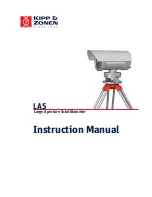
7
1. GENERAL INFORMATION
1.1 INTRODUCTION TO
LAS-BET
AND
LAS-RET
SYSTEMS
The
LAS-BET
and
LAS-RET
(ET stands for evapotranspiration) systems are scintillometer based
surface flux monitoring systems, specially intended for earth energy balance and water management
studies. Evapo-transpiration is an important term of the surface energy budget
s
v
G
E
L
H
Q
+
+
=
*
[W
m
-2
],
(1)
where
Q
*
(or
R
n
) is the available energy known as the net radiation,
H
the sensible heat flux,
L
v
E
the
latent heat flux and
G
s
the soil heat flux. In some cases extra storage and/or advective terms can be
added to the surface energy balance. The evapo-transpiration (
ET
), which stands for the evaporation
(
E
) from bare soil and the transpiration (
T
) by vegetation, is linked to the latent heat flux (
L
v
E
) as
follows
v
v
L
E
L
ET
=
,
(2)
where
L
v
is the latent heat of vaporisation (the energy required to evaporate 1 kg of water,
L
v
∼
2.45
×
10
6
J kg
-1
). This means that ET can be expressed as an energy flux (
L
v
E
in [W m
-2
], mostly used in
used in meteorology) or as a mass flux (ET in [mm day
-1
], mostly used in hydrology). Approximately 1
W m
-2
is equal to 0.0353 mm day
-1
. The latent heat flux or ET is an important term of the soil water
balance
output
input
−
=
∆
S
,
(3)
where
∆
S
is the change of storage of water in the soil, which is the result of the amount of input into
the soil (e.g. due to rainfall or irrigation) minus the amount of loss of water (e.g. due to
evapotranspiration, surface-runoff or drainage).
The
LAS-BET
and
LAS-RET
have been developed to provide area-representative surface fluxes of
sensible heat (
H
) and latent heat (
L
v
E
). Most unique feature of the both systems is the line of sight
path-integrating capabilities of the (eXtra) Large Aperture Scintillometer (
LAS
/
XLAS
). This allows the
user to measure area-averaged surface fluxes of sensible heat at scales of 0.2 to 8 km, over both
homogenous and moderate heterogeneous areas. So far most traditional measurement techniques
(e.g. Eddy-Covariance method, Flux-Profile method, Bowen-ratio method and Lysimeters) are actually
point (
in-situ
) measurements and therefore less representative for large (natural and therefore
heterogeneous) areas.
Basically, the
LAS-BET
and
LAS-RET
system consist of two parts, namely a scintillometer (
LAS
or a
XLAS
) and a weather station (developed by Theodor Friedrichs & Co). The structure parameter (
C
n
2
)
measured by the
LAS
/
XLAS
and additional meteorological data (air temperature at 2 levels, wind
speed and air pressure) collected by the weather station are used to determine the surface flux of
sensible heat
H
. By adding a net radiometer and soil heat flux sensors, the latent heat flux can be
derived, via
s
v
G
H
Q
E
L
−
−
=
*
,
(4)
Summary of Contents for LAS
Page 1: ...Instruction Manual Large Aperture Scintillometer LAS...
Page 28: ...27 Figure 17 Operational weather station of LAS RET system...
Page 29: ...28...
Page 39: ...38...
Page 45: ...44...
Page 49: ...48...
Page 51: ...50 Figure 33 Configuration screen and default settings of supplied RF modems...
Page 55: ...54...
Page 69: ...68...
Page 71: ...70 APPENDIX 9 CONNECTION PLAN LAS BET LAS RET Figure 47 Connection plan LAS BET system...
Page 72: ...71...
Page 73: ...72 Figure 48 Connection plan weather station LAS RET system...
Page 74: ...73 Figure 49 Connection plan scintillometer LAS RET system...























